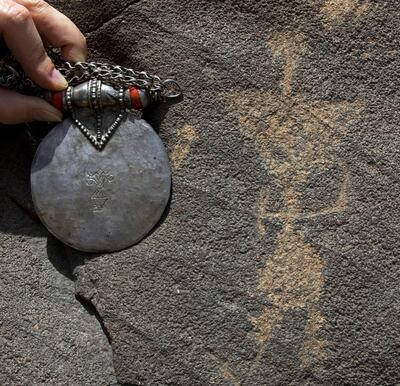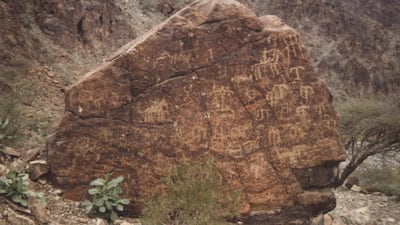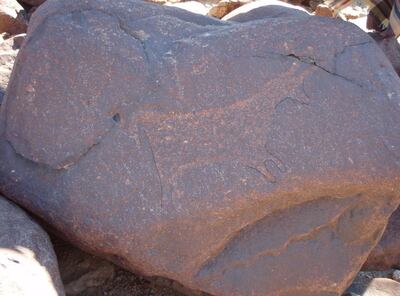The picturesque mountains of Fujairah may swarm with rock climbers and campers today but thousands of years ago, they were the canvas for the people who lived there.
Archaeological studies on the rock art — or petroglyphs — that pepper the emirate’s mountainside have been under way in the UAE for 60 years, despite quarrying and construction threatening their existence.
According to the Fujairah Tourism and Antiquities Authority, FTAA, more than 31 petroglyph sites have been found in the emirate, including sites in Wadi Saham, Hassat al-Risoom, Wadi ah-Shanah, and Wadi al-Hayl.
Some appear to be rough scratchings on a rock surface, others depict animals such as camels and leopards and, in some places, stick figures of humans can also be seen — this is Fujairah’s open-air art gallery believed to date back to the Bronze Age, more than 3,000 years ago.
Petroglyphs are difficult to date without scientific analysis of the rocks on which they are found but some motifs have direct parallels with excavated artefacts from the Iron Age.
Among the motifs discovered is a collective dance scene that provides an insight into the region’s historical development, including agricultural practices.
Much of the work on the petroglyphs was carried out over the past 25 years by UAE resident Dr Michele Ziolkowski, who personally recorded more than 500 individual petroglyphs across Fujairah, Ras Al Khaimah and Hatta.

Dr Ziolkowski came to the UAE in 1993 as an undergraduate student from the University of Sydney and first worked at the Fujairah site on a metallurgy survey. She has since earned her PhD, writing her thesis on the archaeology of Fujairah, and publishing many papers in academic journals about the UAE’s petroglyphs.
She was in a race against time to find and document the rock art before it is lost to quarrying, mining and construction work. In 2010, Dr Ziolkowski recorded 119 petroglyphs in Wadi Daftah before many were destroyed by road construction.
The FTAA is now working to preserve these sites for future generations to learn about the country’s history.
"We are keen on ensuring that these important sites are preserved and maintained, so that residents and tourists are able to view this rock art," Saeed Al Samahi, director-general of the FTAA, told Wam.
"There are 11 petroglyph sites that have undergone preservation work. Other sites are undergoing preservation to ensure they are well-maintained so future generations can have access to their country’s history."
"A large number of carvings and rock paintings have been discovered that they are distinctive to the history of the UAE, providing insight into ancient civilisations and the environment in which they lived.
"We strive to maintain an up-to-date inventory of the petroglyphs,” he said.

The few surviving mountain tribes maintain that the markings serve a much simpler purpose than scientists may believe.
Mohammed Al Shehhi, a member of the prominent Al Shuhouh tribe, previously told The National that he uses several of the petroglyphs as landmarks to find his own ancestral home in the RAK mountains whenever he and his family hike there.
"They are mostly wusum [tribal markings] where areas belonging to particular tribes were marked in a certain way as a message to other mountain tribes," said Mr Shehhi, who was 72 years old at the time.
"It is simple. It is not a coincidence they are often found near burial sites or tombs. They are clearly connected to the tribes."
"Experts always try to complicate it. If a camel was drawn on a rock, then most likely the meaning of the drawing was a camel, perhaps a beloved pet."
_______________
Read more:
Progress threatens rare UAE rock drawings
Fujairah petroglyphs paint picture of ancient UAE
Scientists ask for help to decipher symbols in rock drawings


